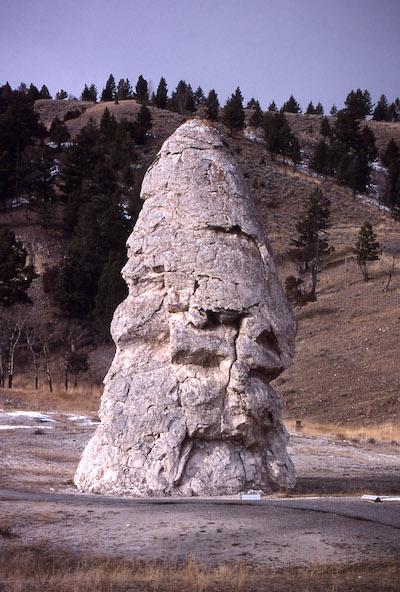
A Chinese visitor was fined $1,000 for leaving a boardwalk to approach Liberty Cap in Yellowstone National Park/NPS, Jim Peaco
A week after a young man died after he wandered far off a boardwalk in Yellowstone National Park's Norris Geyser Basin and fell into a hot spring, a Chinese visitor has been fined $1,000 for walking off a boardwalk in the park's Mammoth Hot Springs thermal area.
Park officials said the unnamed visitor was spotted walking on the terrace formantions near the Liberty Cap formation and collecting water from the thermal runoff. He also was seen breaking througth the fragile travertine crust, according to a park release.
A park ranger took the witness’ statement, photos, and location of the violation.
The subsequent law enforcement investigation identified the individual, who stated that he did not read the safety information given to him at the park entrance. He also admitted to collecting hot springs water. A federal violation notice requiring a mandatory appearance in the Yellowstone Justice Center Court was issued for off-boardwalk travel in a thermal area.
A week ago Colin Nathaniel Scott, 23, of Portland, Oregon, died when he and his sister wandered nearly 700 feet off a Norris Geyser Basin boardwalk and either slipped or fell into a hot spring near Porkchop Geyser. Rangers were unable to recover any of the man's remains from the hot spring, which was slightly acidic and had a temperature of around 199 degrees Fahrenheit.
In the most recent case, park rangers expressed their appreciation for the willingness of the witness to document and report the violation.
Park employees call on all visitors to protect their park and protect themselves. Regulations to stay on designated trails and boardwalks in thermal areas are for visitor safety and the safety of the exceptional park natural resources. Without visitor cooperation, park natural wonders will continue to be damaged and more individuals may be injured or killed. It is a violation of federal regulations to collect any park resources.



Comments
I agree with the fine, but I don't see this as a solution. This is a fragile and precious area. And just like fine works of art in museums are closely monitored at all times, so should Yellowstone features. I feel it is time to end pedestrian free roaming on boardwalks and have strictly guided tours, where a given number of visitors are guided as a group by a NPS staff member/ranger and not allowed to tour these features unattended. Just my two cents.
Hit them where it hurts, and they are likely not to do it again. Flat fine of $1,000 for ANY/ALL visitors who violate National Park policies + $10,000.00 fine against tour company, if visitor is part of a tour. Repeat offenders (individuals/tour companies) permanently expelled from any/all National Parks. Two problems solved here: Drop in visitors who violate Park policies and increase in Park funding.
Laurie - no problem fining the individuals. Fining the tour company for an act committed by someone else that they have no (or at least limited) control over goes too far. It would be like fining a park ranger if someone broke a rule while he was on duty.
Last fall, while I was visiting West Thumb, I found myself picking up scads of trash --- mostly Kleenex type stuff --- that was being freely deposited by a horde of Chinese off a tour bus. I spoke to the tour leader, a Chinese gentleman. He said, "Yes. I am so embarrassed. I tell them and I tell them, but that is just not the way in China."
Even when I returned some tissues to their owners, I was met with uncomprehending looks. In China, there are apparently plenty of people with little brooms who keep the place clean. Gotta provide jobs somehow.
Which is why we shouldn't fine the tour operator.
A fine needs to be something the person can afford or it simply won't be paid. $1000? He can probably pay that. $100000? Almost certainly not.
I did not think that some of these people need protecting. You are right, someone needs to look out for them, but not at the risk of the
rescuscer's saftey as someone else in need may truly need them.
Just returned from a six week tour of seven national parks in Utah and Arizona. Noticed that the Asian tourists ignored most all posted regulations. This included camping in picnic areas with no camping signs in plain view, as well as car camping overnight in parking lots posted the same. They appear to believe the rules don't apply to them. And, if fined, do they pay before they return home? Probably not.